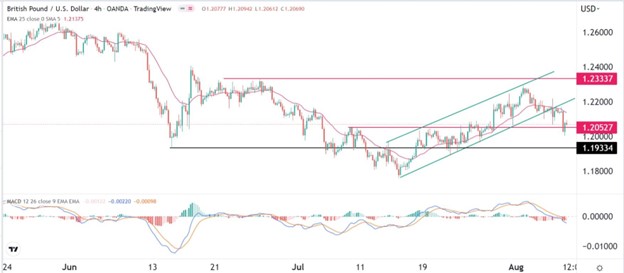Bearish View
- Sell the GBP/USD and set a take-profit at 1.1900.
- Add a stop-loss at 1.2150.
- Timeline: 1-2 days.
Bullish View
- Set a buy-stop at 1.2130 and a take-profit at 1.2200.
- Add a stop-loss at 1.2065.
The GBP/USD price came under pressure on Monday morning as investors focused on the strong American jobs numbers. The pair was trading at 1.2070 on Monday, which was lower than last week’s high of 1.2295.
Hawkish Fed After US jobs data
The GBP/USD pair made a strong bearish breakout last week even after the Bank of England (BoE) decided to hike interest rates by 0.50%. This was the biggest rate hike since 1994 and is a sign that the bank is committed to continuing with its battle against inflation.
However, the bank also warned that the UK economy was in danger of moving to a recession in the fourth-quarter of the year. This warning implied that the BoE will likely slow the pace of its interest rate hikes later this year.
The GBP/USD pair also dropped after Nancy Pelosi’s trip to Taiwan. Shortly after the trip, China started drills on how it will finally attack Taiwan. These drills continued during the weekend and analysts believe that China will likely accelerate its invasion plans.
The other main catalyst for the sterling sell-off was the strong American jobs data. According to the Bureau of Labor Statistics (BLS), the economy added over 525k jobs in July, a major surprise because of the recent trends in the labor market. Companies like Microsoft, Oracle, Robinhood, and Netflix have all announced layoffs this year.
The unemployment rate dropped to 3.5% while the participation rate continued rising. Notably, wages continued rising in July even though they are growing at a slower pace than inflation. Therefore, these numbers will likely put pressure on the Federal Reserve to continue tightening.
The key data to watch this week will be the upcoming US consumer and producer inflation data and the latest UK GDP numbers.
GBP/USD Forecast
The four-hour chart shows that the GBP/USD pair was in a bullish trend since July 15th. As it rose, the pair formed an ascending channel pattern that is shown in green. It managed to move below the lower side of the channel after the BOE decision and the US NFP data.
It has dropped below the 25-day and 50-day moving averages and is slightly above the important support at 1.2052, which was the highest point on July 8th. The MACD has also moved slightly below the neutral level. Therefore, the pair will likely continue falling as sellers target the support at 1.1900.

Ready to trade our free daily Forex trading signals? We’ve shortlisted the best Forex trading brokers in the industry for you.
